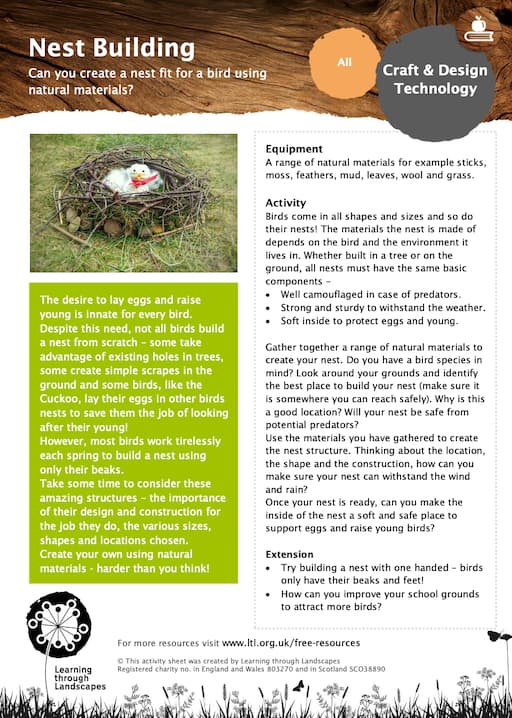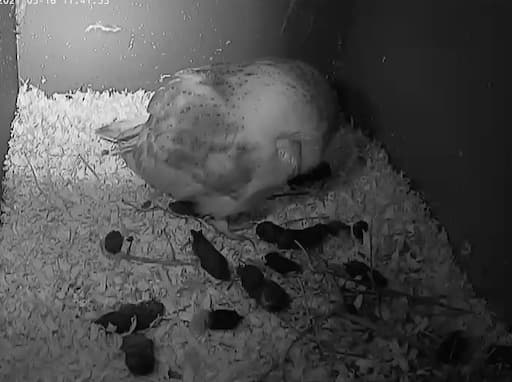Examples Of Nests
What is a bird nest? - This is a shelter made by birds for its eggs and young. The nest protects the eggs and once the eggs hatch the young are protected in the nest as their parents feed them. Each bird nest type is designed for a particular site and the site in which it is located provides the materials… it is amazing to think that a bird builds these well weaved nest with their beak and legs… why don’t you try building a nest!?
There are lots of different sorts of nest.
Blackbird Nest makes a cup – shaped nest constructed from a mixture of mud, straw and dry grasses, built into a number of interlocking twigs and branches. The female just builds the nest. The nest contains 2 to 6 eggs and the bird will nest two or three times a year and the first clutch is in April. For more information: Blackbird Breeding (RSPB).
Rook Nest - Rook nest socially wedged in the forks of high trees. The nests are made of large interlocking sticks then lined with soft grass and sometimes leaves. You will find the most senior birds in the centre of a rookery with young birds (juveniles ) on the outer edge for or more information look at: Woodland Trust: Rook
Long Tail Tits - Hiding in prickly bushes this is a domed nest is a compact mixture of moss mixed with gossamer (a fine, filmy substance consisting of cobwebs spun by spiders) and lined with feathers. Outside is embedded with hundreds of flakes of lichen. It can contain hair, wool. Fine bark and other loose material. In takes two birds in a mating pair two weeks to make…this is even more remarkable when you think that a long tail tit can make a nest in its first year having been never been shown how to do!
House Sparrows - This bird uses holes in buildings, ledges, crevices and dense foliage as the nest is a cluster of gently bent straws and a bed of feathers not woven but loosely entwined. Woven nests take a vast amount of time and energy so hose sparrow conserves energy for feeding and allow time for many clutches of eggs
Some examples of nest sites
Ospreys - Often on the top of a very tall tree ospreys are summer visitors and are site faithful which means the return every year. There are a few ospreys in the Bennachie area that will on fish found in the river Don. You can watch the ospreys on the Woodland Trust osprey cam: Osprey Cam
Great Spotted Woodpecker - Make their nest inside the tree truck hollowing out the nest chamber by chipping away the wood with their beaks. This process can take around three weeks with the inner cavity chipped smooth. Often you hear drumming in spring from woodpeckers it is not them working on their holes it is in fact equivalent of song made as a mating call and to communicate each woodpeckers territory. A woodpecker will not reuse its hole the following year.
Examples of nest materials
Wood Pigeon Nest - Their main breeding time is April to October but they can nest all the year round. Woodpigeons use same length twigs to form a flimsy raft like platform. Often these platforms are thin and light can be seen through the nest allowing their pale eggs to disappear . Twigs are available all year round so this simple structure enables more breeding attempts.
Chaffinch - Tucked into the fork of a tree a tiny cup nest made from moss, spiders web and feathers. The Chaffinch is clever and worked out that the moss and spiders web work like Velcro – the moss has tiny hooks and the spiders web is full of loops. The elastic nature of the materials means that the cup shape is flexible as the young grow. The female makes the nest and lays up to 6 eggs that are pale brown/blue/red or grey/ the eggs are incubated for 2 to 13 days and young stay in the nest for 14 days. Check out this link to learn more: Garden Birds - Chaffinch
Swallow - This is a summer visitor to Bennachie flying back and forth from Africa and builds in nest from mud and is usually inside the building.
House Martins – also are summer visitors and build their mud nests affixing to the outside usually under overhangs. Each time the bird adds a layer of mud it vibrates it which brings water to the surface creating a bond with the next layer!
Just for Fun, Build your Own Nest!
Now try nest building yourself read the instructions for Nest Building and see how you get on.
Share your photos with Jock! We will pop the best photos on the web site.
We will pop the best photos on the web site.

Did you know young pigeons (Squabs) are fed by both parents on a liquid known as crop or pigeon milk.

This is part of the Birds In Spring information.